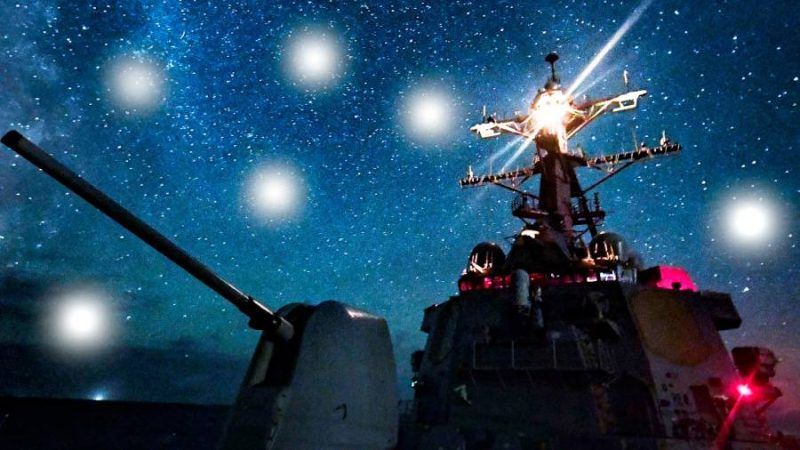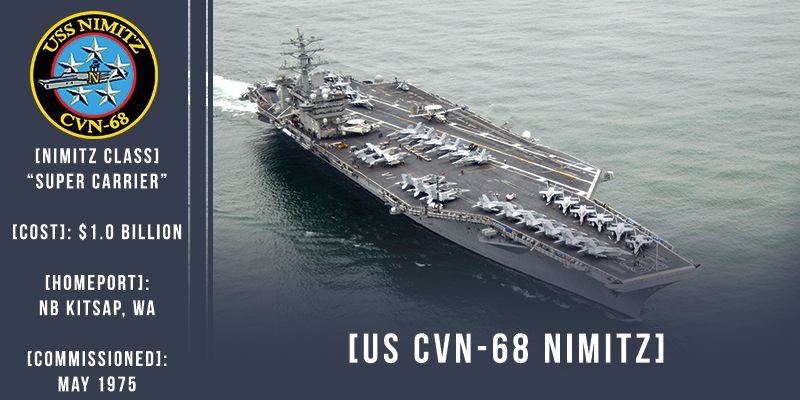US Navy Destroyers Swarmed by Mysterious ‘Drones’ Off California in 2019
Article by Adam Kehoe and Marc Cecotti March 23, 2021 (thedrive.com)
• On July 14, 2019, a group of US Navy ships were conducting exercises about 100 miles off Los Angeles, near San Clemente island, and south of the Channel Islands off of Ventura/Santa Barbara. Around 10:00 pm, the US Navy destroyer, the USS Kidd logged the sighting of two “UAVs” or ‘unmanned aerial vehicles’, more commonly referred to as a ‘drones’. In addition to utilizing some of the most sophisticated sensors on Earth, a “SNOOPIE team” – or ‘Ship Nautical Or Otherwise Photographic Interpretation and Exploitation’ team, ie: a group of sailors with consumer-grade cameras – was deployed to track and record the UAV drones.
• Ten minutes after the initial sighting, the USS Kidd advised the USS Rafael Peralta of the situation, and the second destroyer activated its own SNOOPIE team. Reports of additional sightings were coming in from a third destroyer, the USS John Finn. The USS Rafael Peralta described a ‘white light’ hovering over the destroyer’s helicopter landing pad, matching the ship’s speed at 16 knots (about 18 mph) as it operated in low visibility weather conditions and at night. This continued for over 90 minutes—significantly longer than what commercially available drones can sustain.
• As this was going on, the civilian bulk carrier Bass Strait was situated towards the northern edge of the encounter area. A Liberian-flagged oil tanker, the Sigma Triumph, was just south of the position of the three destroyers. And the 50-foot catamaran, the ORV Alguita, was just off the western tip of San Clemente Island.
• On the following night, July 15th, 2019, the USS Rafael Peralta spotted the drones again at 8:39 pm. By 9:00 pm, the USS Kidd also spotted the drones. This time, the ships were located further south and closer to shore, between San Diego and San Clemente Island. The drones seem to pursue the ships as they maneuvered. By 9:20 pm, the USS Kidd log reads: “Multiple UAVs around ship”.
• At 9:37 pm, the command was issued to man Mark 87 stations – the Mk20 Electro-Optical Sighting System (EOSS) located above the bridge, which provides surveillance and tracking over long distances. At about the same time, logs from the Navy destroyer USS Russell describe the drones dropping in elevation, and apparently moving forward and backward, left and right.
• Meanwhile, the USS Rafael Peralta received a radio call from a passing cruise ship, the Carnival Imagination, notifying the Navy that the drones were not theirs, but they could see as many as five or six drones maneuvering nearby. The incident continued into the night, with the USS Rafael Peralta recording two drones, and then four drones near their own ship. This continued for nearly three hours, but none of the warships were able to identify the drones.
• A formal investigation appears to have been launched on July 17th. By the morning of July 18th, a Navy liaison to the Coast Guard and the Naval Criminal Investigative Service (NCIS) assigned to 3rd Fleet got involved. Their findings would go directly to the commander of the Pacific Fleet and to the Chief of Naval Operations. The initial focus of their investigation was the 50-foot catamaran, the ORV Alguita. While the ORV Alguita did have drones onboard, they were small quadcopter drones with a maximum flight time of 28 minutes and incapable of operating more than a few feet from the ship. Also, they were not operating at the time of the incident. Navy investigators conceded that they needed to keep looking.
• Next, Navy intelligence and the director of the Maritime Intelligence Operations Center sought to rule out the possibility that the drones were operated by the Navy itself. A representative from the Fleet Area Control and Surveillance Facility based in San Diego clarified that UAV drones were only operated by the Navy in certain limited areas. By the afternoon of July 23rd, the investigators were still grappling with the intent behind the incidents.
• Remarkably, the USS Kidd detected the drones again in the early hours of July 25th and July 30th. Further information continues to emerge from The Drive’s FOIA requests, but based on the available evidence it appears that the initial investigation did not ultimately identify the source of the drones. It remains uncertain if other ships also continued to have drone encounters in July.
• It is unclear why anyone would operate drones near Navy warships in such a brazen manner. Commercially available drones are not usually capable of flying for such long durations across great distances at relatively high speeds. It is estimated that the drones traversed at least 100 nautical miles during the July 14th incident. The drones were able to locate and catch a destroyer traveling at 16 knots in conditions with less than one nautical mile of visibility. Equally baffling, their operators appear to have coordinated at least five to six drones simultaneously.
• Is it possible that the drones were operated from the Navy’s nearby training area on San Clemente Island in an errant test of some kind? No UAV activity was scheduled during July 14th. If there were classified drone exercises, why would the incursions continue after an investigation that reached the highest level of the Navy hierarchy? This is the same area where the ‘Tic Tac’ UFO (and the ‘fleet’ of them according to a Navy pilot’s remark) was seen in 2004.
• If the drones were not operated by the American military, these incidents represent a highly significant security breach. If they were part of some kind of covert action, it is nonetheless unclear why they were flown so openly and so frequently in almost a harassing manner. More troubling still, if a foreign state actor was involved, where exactly were the drones launched from? And was there ever a hard description of these craft beyond ‘lights in the sky’?

In July of 2019, a truly bizarre series of events unfolded around California’s Channel Islands. Over a number of days, groups of unidentified aircraft, which the U.S. Navy simply refers to as ‘drones’ or ‘UAVs,’ pursued that service’s vessels, prompting a high-level investigation.
Islands. Over a number of days, groups of unidentified aircraft, which the U.S. Navy simply refers to as ‘drones’ or ‘UAVs,’ pursued that service’s vessels, prompting a high-level investigation.
During the evening encounters, as many as six aircraft were reported swarming around the ships at once. The drones were described as flying for prolonged periods in low-visibility conditions, and performing brazen maneuvers over the Navy warships near a sensitive military

training range less than 100 miles off Los Angeles. The ensuing investigation included elements of the Navy, Coast Guard, and the Federal Bureau of Investigation (FBI). The incidents received major attention, including from the Chief of Naval Operations—the apex of the Navy’s chain of command.

The following is our own investigation into these events, during which we discovered these events were far more extensive in scale than previously understood.
A Strange Story Emerges

Last year, documentary filmmaker Dave Beaty uncovered initial details about the events, centering on the Arleigh Burke class destroyer USS Kidd (DDG-100). That initial account described a tense encounter, culminating in the deployment of onboard intelligence teams.

New documents significantly expand the public’s knowledge of the scope and severity of that incident and reveal others that occurred around the same time. These details come largely from our Freedom of Information Act (FOIA) requests, which resulted in the disclosure of deck logs from the ships involved. Additionally, our investigation utilized hundreds of gigabytes of automatic identification system (AIS) ship location data to forensically reconstruct the position of both military and civilian ships in the area during this strange series of events.
By using the USS Kidd’s position as a starting point, we were able to identify several other ships in close proximity to it during the incidents in question, including U.S. Navy destroyers USS Rafael Peralta, USS Russell, USS John Finn, and the USS Paul Hamilton. Subsequent FOIA requests for these ships’ records allowed us to build a composite picture of the events as a whole.
FAIR USE NOTICE: This page contains copyrighted material the use of which has not been specifically authorized by the copyright owner. ExoNews.org distributes this material for the purpose of news reporting, educational research, comment and criticism, constituting Fair Use under 17 U.S.C § 107. Please contact the Editor at ExoNews with any copyright issue.





